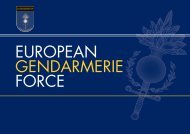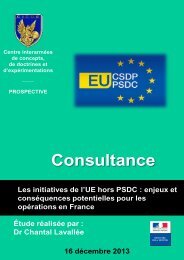Conference
science-research-bulletin-2013-conference
science-research-bulletin-2013-conference
Create successful ePaper yourself
Turn your PDF publications into a flip-book with our unique Google optimized e-Paper software.
EUROPEAN POLICE SCIENCE AND RESEARCH BULLETIN<br />
SPECIAL CONFERENCE EDITION<br />
since policing in all those places involves<br />
intervention in situations that ‘ought-not-tobe-happening-and-about-which-someone-hadbetter-so-something-now’<br />
(Bittner, 1974, p. 17).<br />
Furthermore, policing agents have the capacity<br />
to muster coercive force, or threaten to do so, in<br />
order to get the job done. Additionally, so-called<br />
‘democratic policing’ requires that such use of<br />
force is proportionate and the minimum amount<br />
necessary to get the job done. For example, if<br />
members of the public will not step back from<br />
the scene of an accident so that ambulance<br />
personnel, paramedics, and other emergency<br />
first-responders can properly attend to the<br />
scene, it is the police who have the authority to<br />
move the crowd. These features of police work,<br />
shared by policing agents the world over, mean<br />
that there is something of a ‘family resemblance’:<br />
a transnational subculture of policing so to<br />
speak. Police agents recognise their membership<br />
in this subculture. For example, when police<br />
officers go abroad on vacation, they sometimes<br />
bring with them emblems and other symbolic<br />
representations of their own organisation that<br />
they exchange with police they may meet in<br />
the countries they are visiting. Visit any police<br />
headquarters building and one will usually find<br />
a display symbolic paraphernalia from other<br />
agencies around the world, displayed with pride<br />
— perhaps in the corridor just outside the Chief<br />
Officer’s office or in the reception area where<br />
more visitor traffic ensures a greater audience of<br />
appreciation. This is evidence of a transnational<br />
subculture of police. Subcultural theory is<br />
interesting because it encourages an appreciation<br />
of what the world looks like ‘from within’ the<br />
subculture, while at the same time allowing the<br />
subcultural theorist to place that worldview within<br />
a broader context. The ideology of the ‘thin blue<br />
line’ looks different if you are, or are not, part of<br />
the ‘subculture’. All the while policing subculture<br />
reflects important aspects of the broader culture<br />
of which it is a contributing part.<br />
If we can theorise a transnational subculture of<br />
policing, there is also a recognisable subculture<br />
of transnational policing. These agents are<br />
described by Robert Reiner as international<br />
technocratic police experts who disseminate<br />
the latest in scientific and technological<br />
solutions for a constantly innovating global<br />
police professionalism (Reiner, 1997, p. 1007).<br />
Transnational technocratic police experts have<br />
important effects on policing at the local level,<br />
and that is why the transnational subculture<br />
of policing is becoming more homogenous,<br />
despite the residual variation. This interactive<br />
process between the transnational subculture<br />
of policing and the subculture of transnational<br />
policing contributes to and ‘makes up’ Global<br />
Policing. Into this occupational mix we wish to<br />
insert a range of concerns signaled by the idea of<br />
a Constabulary Ethic.<br />
The subcultures of policing thus theorised are<br />
mixed up in global cultural reproduction more<br />
generally and a great many volumes have been<br />
written about this (Reiner, 1997). One facet of<br />
this that cannot escape particular mention is<br />
the tendency for the occupational subculture of<br />
policing to be excessively shaped by a pattern<br />
of political language which articulates in terms<br />
of a ‘war on crime’, a ‘war on drugs’, a ‘war on<br />
terror’ and other, slightly less martial metaphors<br />
such as: ‘law enforcement’, ‘crime control’,<br />
‘deterrence’, ‘disruption’ and ‘incapacitation’.<br />
The complex interplay between general culture<br />
and particular subcultures is conceptually<br />
difficult to elucidate, but one simple point can<br />
be made: unduly combative language in policing<br />
heightens the stakes for an already tainted<br />
occupation. Subcultural theory offers a useful<br />
way to approach and understand global policing<br />
but, saying this, we are not intending to reify the<br />
concept as an object of governance. It is merely<br />
a way to help make global policing theoretically<br />
visible. What remains interesting is the actual<br />
work of policing, but with the higher stakes that<br />
war rhetoric brings comes a cloak of secrecy<br />
behind which ethically questionable practices<br />
remain hidden. That is one good reason why<br />
truly independent academic research on policing<br />
maintains continuing relevance.<br />
POLICING; IATROGENESIS<br />
AND THE SECURITY-CONTROL<br />
PARADOX<br />
The original idea of a science of policing was<br />
concerned with establishing a stable set of<br />
arrangements between the organs of stategovernment<br />
and civil society to maximise total<br />
welfare. Under transnational conditions the<br />
state is no longer the container of insecurity that<br />
the modern nation-state system envisaged and<br />
policing practice has transcended the boundaries<br />
of ‘the state’. Of all of the outcomes of these<br />
circumstances the problem of iatrogenesis is<br />
the greatest (Bowling, 2010). Iatrogenesis is a<br />
17





